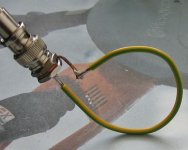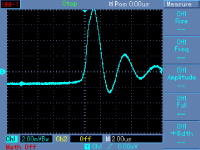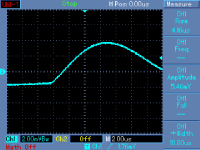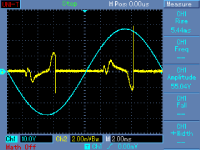Make it switchable and give the consumer a choice - especially on a peice of equipment costing thousands of $.
Not everyone has 'flat records' (especially if they collect 'old vinyl') and you need to have a really good turntable (1000's of $ also) to be able to put hand on heart and say 'I have no rumble - its absolutely inaudible'.
Not everyone has 'flat records' (especially if they collect 'old vinyl') and you need to have a really good turntable (1000's of $ also) to be able to put hand on heart and say 'I have no rumble - its absolutely inaudible'.
From What I remember it was the thought of lower impedance secondary ps audio first spoke of with small current requirments so the current pulse was small.
I go by a rule of thumb of 2x to 3x the rated output of both channels. So for a 100W stereo amp, I use a 500VA core for class AB.
For class A, I go 8x to 10x rated power e.g. 15W per chan class A I use a 250VA transformer.
But, I think you have to consider the transformer in conjnction with the cap filterbank as well - i.e. the total thing.
I am using a very nice supplier here in Taiwan ('Power Star')and can get screens and bellybands incorporated which is usually not the case for off the shelf units.
The ' mystery ' being that current instrumentationOverbuilding is just one way of making a conventional power supply work a bit better than they normally do - no mystery in it at all. It's very easy to hear PS problems in most amplifiers, typified by the quality degenerating into classic "hifi" sound ...
cannot measure the affects of ' overbuild ' .......
BUT .... Ears can hear it ........
From What I remember it was the thought of lower impedance secondary ps audio first spoke of with small current requirments so the current pulse was small.
The lower internal R of the bigger transformer with lower resistance secondary would mean a bigger charge pulse and shorter conduction angle. That usually leads to more power line frequency related electrostatic and electromagnetic noise from the supply. It will also mean a lower peak voltage available (peak current X resistive drop from the AC source) and much higher strain on all the connections. Perhaps that can be euphonic (add texture to the bass) in the right conditions?
The high end industry is way too quick to leap to desired conclusions when something is observed. Perhaps the biggest roadblock to actual progress.
The lower internal R of the bigger transformer with lower resistance secondary would mean a bigger charge pulse and shorter conduction angle. That usually leads to more power line frequency related electrostatic and electromagnetic noise from the supply.
Exactly, that's how it is. And, a necessity of two - stage turn on, otherwise the initial transient magnetizing current of the big toroidal transformer activates house circuit breakers.
Thank you Demian
It is obvious that you are an ‘expert’ of a ‘different’ kind.
Pavel
I am certain you didn’t miss the broader meaning of Demian’s post
George
It is obvious that you are an ‘expert’ of a ‘different’ kind.
Pavel
I am certain you didn’t miss the broader meaning of Demian’s post
George
Well, I was hoping that my "innocent" question in 50892 would lead hitsware and thom to figure it out for themselves and maybe, just maybe, start questioning fashion audio folklore. Thanks, Demian, for the spoiler!
How's that a spoiler ? 🙄
Me thinks you actually should start listening to audio instead of reading about it, no one listens to bad audio because you think it doesnt work, all that has been pointed out is there's a wrong and right way to implement ideas , those successful at it , have learnt to balance the science with what they hear.
Would love to hear one of your perfect audio products, the last time i looked persons buying audio products did so to listen to music, things like fatigue(or lack their of), musicality , dynamics , soundstage , depth and lifelike reproduction , were necessary and important to them before fiat currency gets exchanged .
Feel free to point out the magic specs neccessary to do so , you may just be the one get it done.

Me thinks you actually should start listening to audio instead of reading about it, no one listens to bad audio because you think it doesnt work, all that has been pointed out is there's a wrong and right way to implement ideas , those successful at it , have learnt to balance the science with what they hear.
Would love to hear one of your perfect audio products, the last time i looked persons buying audio products did so to listen to music, things like fatigue(or lack their of), musicality , dynamics , soundstage , depth and lifelike reproduction , were necessary and important to them before fiat currency gets exchanged .
Feel free to point out the magic specs neccessary to do so , you may just be the one get it done.

Last edited:
And Pavel tried not to scare us much.
His one turn H probe, can’t pick-up the complex EM near field, although he correctly probes at the most offensive location for a toroidal xformer.
George
His one turn H probe, can’t pick-up the complex EM near field, although he correctly probes at the most offensive location for a toroidal xformer.
George
Not much (if I am allowed to be that non-specific as your question is)
The worst radiator is the loop formed by the secondary winding, rect bridge, 1st smoothing cap.
Keep that loop -not specifically the xformer- away from sensitive circuitry.
Reduce the physical area of that loop.
Use twisted wires to further reduce the effectivelly transmiting area.
Reduce the peak charging current that flows through the loop and reduce the frequency content by increasing the charging time.
George
The worst radiator is the loop formed by the secondary winding, rect bridge, 1st smoothing cap.
Keep that loop -not specifically the xformer- away from sensitive circuitry.
Reduce the physical area of that loop.
Use twisted wires to further reduce the effectivelly transmiting area.
Reduce the peak charging current that flows through the loop and reduce the frequency content by increasing the charging time.
George
Last edited:
No subsonic filters for me, thank you. Flatten your records.
Practical solution anyone, I thought the vacuum hold downs sucked the life out of the other side and clamps only work somewhat.
All subsonic filters further destroy the low frequency transient response.
I guess we need digital removal. 😀
What happens when that bigger transformer is 5 ft away ..?
Then take care about charging current spikes into filter capacitors and magnetic field radiation from wires between transformer and rectifier.
Me thinks you actually should start listening to audio
Yeah, that must be it, I don't listen to audio.
🙄
When doing power supplies my direction is to slow down the current pules as much as I can. Choke help moving in the opposite direction from audio fashion in this case. Toroid transformer have a high inrush current from what I seen . My reference to lower current pluses was after the cap bank is charged up sorry for not saying that. Ps audio has since played with the wave form of the ac in their power station . A better choose is right sized transformer balanced clc then some regulation close to the active circuit. Me thinks.Well, I was hoping that my "innocent" question in 50892 would lead hitsware and thom to figure it out for themselves and maybe, just maybe, start questioning fashion audio folklore. Thanks, Demian, for the spoiler!
- Status
- Not open for further replies.
- Home
- Member Areas
- The Lounge
- John Curl's Blowtorch preamplifier part II



